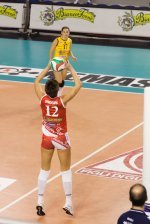Volleyball Terminology
Volleyball terminology for learning more about the great sport of volleyball.
Volleyball Terminology for Attacking
Attack Attempt: When a player makes an attempt terminate the play by hitting the ball.
Attack: The action of hitting the ball toward the opponent. You attack the ball to try to score.
Attacker: Also “hitter” and “spiker.” The attacker is the player who attempts to hit a ball with the purpose of scoring a point for the team.
Attack Line: A line 3 meters from the net that separates the court front row from the back row.
A: The A Ball is the back-row attack near the left sideline (A-B-C-D)
B: The B Ball is the back-row attack between the left sideline and the midline of the court (A-B-C-D).
Broad jump: When an attack leaps forward to attack a set.
Cross-Court Attack: An attack that is spiked diagonally cross-court.
Cross-Court Serve: A serve traveling cross-court.
Hit: Same as spike or attack.
Hitter: Also “spiker” or “attacker.” The player who is responsible for spiking the ball. This is the player the setter sets the ball to.
Hitting Percentage: A statistic derived from total kills minus total attack errors, divided by total attempts.
Volleyball Terminology for Serving
Ace: A serve that results directly in a point, usually when the ball hits the floor untouched. Sometimes if the ball is deflected and still results in a kill, this is also an ace.
Floater: A serve with no spin that bounces in the air.
Volleyball Terminology for Defense and Blocking
Dig: This the skill of passing a hard hit ball.
Block: A defensive action at the net of a player near the net, reaching higher than the top of the net with the intention to deflect the ball. Intercepting the ball to prevent the ball from crossing the net.
Block Solo: A successful block by an individual front row player that results in win of point.
Blocking Error: A violation that consists of touching the net, crossing the center line, blocking a set or any other violation which occurs while making a block attempt.
Cover the hitter: The act of positioning for a block by the opponent.
Double Block: Two players working in together to intercept a ball at the net.
Volleyball Terminology for Offense
Assist: The player that gets credit for assisting the attacker gets an assist for the successful attack.
Bump Pass: Same as forearm pass. Using the forearms to pass.
Bump: Lingo for forearm passing.
Chester: Getting tagged in the chest with a spike.
Closing the Block: The outside blocker moving to get in position to close the block.
D: a back-row attack near the right sideline (A-B-C-D)
Decoy: A player on the team that pretends to approach to spike in order to trick the opponent.
Volleyball Terminology for Offense Plays
Back one: A quick set to an attacker placed directly behind the setter.
Five Set: Set to the right front hitter with a back set
Dump: Usually performed by the setter, who delivers the ball into the opponent’s court on the second contact.
Back Row Attack: A back row player attacks the ball. They do this usually by jumping from beyond the attack line.
Back set: A set delivered backwards from the setter. The setter’s back is towards the hitter.
Back slide: a quick slide behind the setter.
Cross: A combination play where the path of one attacker crosses the path of another attacker.
Cross Court Shot: An individual attack directed at an angle from one end of the offensive team’s side of the net to the opposite sideline of the defensive team’s court.
Double-Quick: A combination play where two attackers are coming quickly for a quick set. The two hitters usually approaching the setter in the middle of the court.
Combination: An offensive play that involves two attackers entering a single blocker zone of the net.
Joust: When two opposing players contact the ball simultaneously above the net causing the ball to momentarily come to rest. A joust is a block and play continue.
C: A C Ball is a back-row attack between the midline of the court and the right sideline.
Volleyball Terminology for About the Court
Court Dimensions: The court is 59 feet from end line to end line and 29 feet, 6 inches wide (18m x 9m).
Center Line: This is the line running under the net that divides the court into two equal halves.
Antenna: vertical poles attached to the outside edge of the net. The antenna is in line with the court boundary lines.
Baseline: The end line of the court.
Back row: The back row is the area of the three players positioned is near the baseline.
Front-row: The front row is where the three players near the net are positioned.
Volleyball › Volleyball Terms › Volleyball Terminology
ACCESS MY STRENGTH SECRETS




